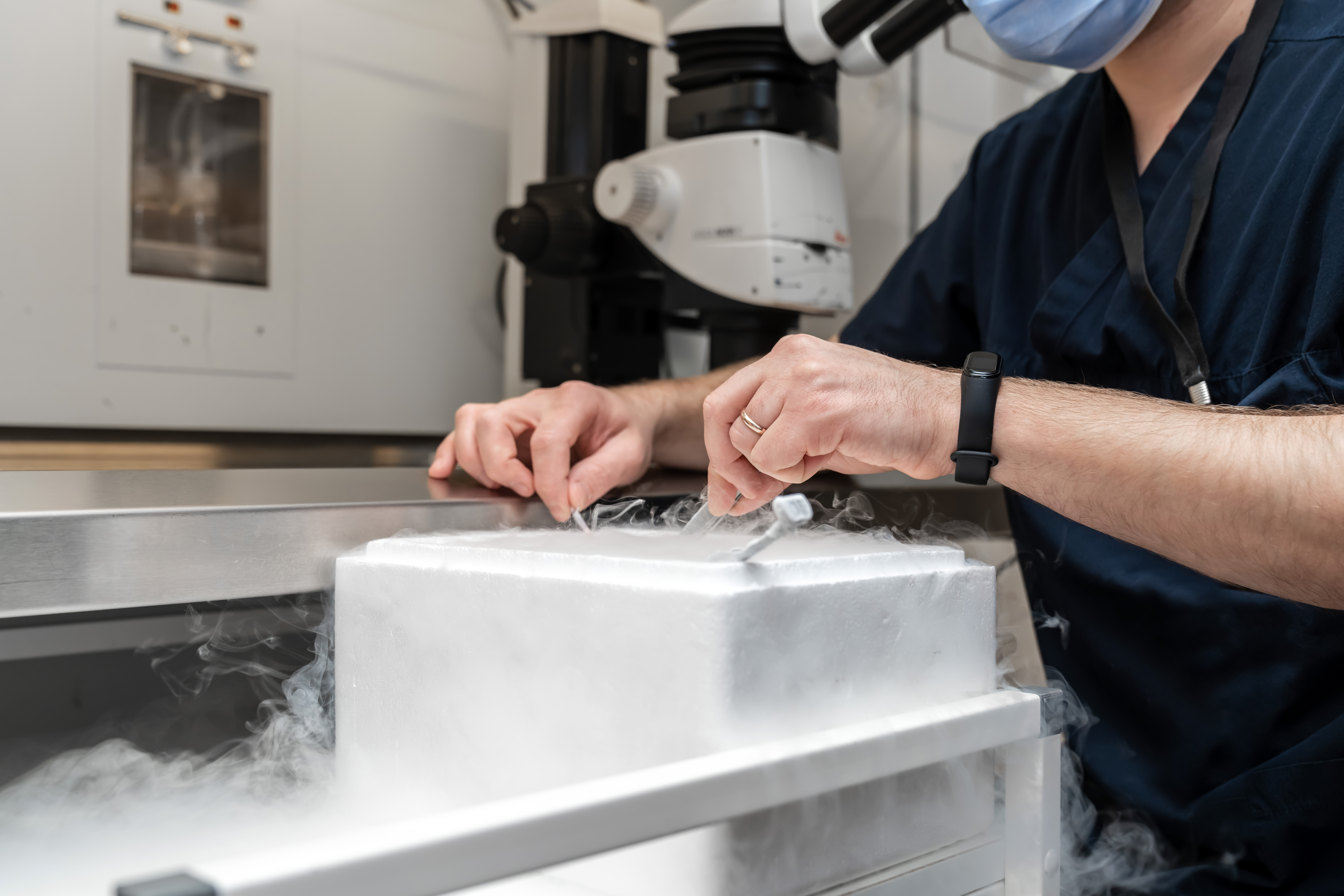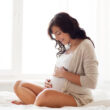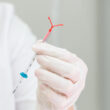I still remember late in my first pregnancy when my midwife instructed me on how to do perineal massage. My jaw dropped to the floor while I uttered a resounding, “Heck no.” But perineal massage does have its benefits. 9 out of 10 first-time moms will experience tearing of some sort during childbirth. First- or second-degree tears tend to heal much quicker and without medical intervention, whereas third- or fourth-degree tears will require stitches to repair, and will result in significant pain and discomfort (FYI, if this was your experience, a pelvic floor physical therapist is specially trained to help women who experience severe tears). Perineal massage is a preventative measure you can take prior to birth to help prevent damage to the skin of the birth canal.
What is a perineal massage? How do you do it? Does it hurt? Read on to learn answers to these questions, some stats on how effective perineal massage is at reducing tearing during birth, and more.
Where is my perineum? How do I massage it?
The perineum is the space between the vaginal opening and the anus, which is probably not an area you’ve thought much about previously. By repetitively massaging this space and stretching it over time, the idea is that you reduce the chance of tearing during birth. It is recommended to do 3-4 times a week for 3-4 minutes from 34 weeks gestation until labor starts.
It’s helpful to use an oil, like olive oil or coconut oil—any kind of natural oil you would put on your face is a safe bet. Make sure your hands are clean, and find a comfortable position. One woman may prefer to put one foot up on the toilet or bathtub, while another may feel more comfortable lying down reclined on her back. Using your thumbs, press down on the base of the vaginal opening going up and down, making a u-shape. You may feel a slight stretching or burning. It’s ok to start slow and work up to doing the stretches for longer times. Some women like to involve their partner in this practice.
How effective is perineal massage in decreasing tear risk?
In one 2018 randomized controlled trial (the gold standard of research study formats) of 108 Nigerian women, 49.1% of women who received prenatal perineal massage experienced a tear during childbirth, as compared to 71.9% of women who did not receive perineal massage [1]. The study authors concluded, “Obstetricians should consider the technique as routine prenatal care for nulliparous women so as to reduce the incidence of perineal trauma during vaginal birth” (emphasis added).
Similarly, a 2020 randomized controlled trial of 400 Egyptian women over the age of 35 who were educated to self-perform perineal massage, found that women who repetitively did this simple action had significantly lower rates of tearing. Furthermore, in those women who still tore, the majority of tears were less serious (first or second degree) tears [2].
Finally, a 2020 meta-analysis (which is a study of studies) of research on women who received perineal massage only during labor still had notably decreased rates of tearing [3].
What else can I do to protect my perineum during labor?
The best way to avoid too much tearing during birth is to listen to your body. Push when you feel the urge to push, and don’t push if you don’t. It’s important to breathe through your pushes—rather than performing the “valsalva maneuver,” which is holding your breath while bearing down.
A warm compress during birth is something a doula (or supportive partner) can apply to your perineum during labor. And if you are open to a water birth, water helps immensely with protecting the perineum. Birthing in biologically appropriate positions—pretty much anything except on your back—can help prevent tearing. Be aware, too, that epidurals do come with a 1.95 times increased risk of tearing [4]. This is probably because, while epidurals take away the pain, women also lose the sensation of how aggressively (or not) to push.
Of course, some factors of birth are entirely out of our control, such as the baby’s position (which way his or her head is facing during labor and birth) and size. And, unfortunately, some women may simply be more prone to tearing (on that note, a 2000 study found a higher risk of tearing for women who experienced stretch marks) [5].
What can I do to heal my perineum if I do tear?
Some tearing is almost a given for first-time moms, though fortunately your risk decreases with subsequent babies, and with utilization of the preventive measures listed above. First- or second-degree tears will generally heal in a matter of weeks. Third- and fourth-degree tears require, at a minimum, dissolvable stitches to repair, and these more serious tears may physically hamper your ability to take care of your baby. Having a postpartum plan identifying support people who can pitch in to cover household or baby care tasks that are simply too painful at first is essential.
No matter what degree of tear you have, herbal sitz baths and frozen witch hazel pads can be healing to any trauma sustained to this sensitive area. You should also avoid sitting upright on your bottom for too long. Since straining to pass a bowel movement will only exacerbate the pain and discomfort you already feel from tearing, increase your fluid intake and add high-fiber foods like fruits, veggies, and beans to prevent constipation. Fortunately, in the long term, perineal massage can also help heal scar tissue. And if you got stitches, know that the new tissue that grows in may not stretch as well as your original vaginal tissue, possibly requiring perineal massage before or during future labors.
You’ll need to listen to your body before resuming sexual intimacy, and due to soreness and tenderness, you may not feel ready by the customary six-week post-birth “all clear” timeframe. When you do get cleared for sex and exercise by your healthcare provider, do yourself a favor and seek out a pelvic floor physical therapist (even if you were fortunate enough to have minimal tearing after birth!).
If you’re approaching your due date (and especially if you are a first-time mom) know that research backs the use of perineal massage to decrease your risk of tearing during birth. It might be just the thing to add to your nightly routine in preparation for the big day!
References:
[1] Ugwu, Emmanuel Onyebuchi et al. “Effectiveness of antenatal perineal massage in reducing perineal trauma and post-partum morbidities: A randomized controlled trial.” The journal of obstetrics and gynaecology research vol. 44, no. 7 (2018): pp. 1252-1258. doi:10.1111/jog.13640 [2] Dieb, Amira S et al. “Perineal massage and training reduce perineal trauma in pregnant women older than 35 years: a randomized controlled trial.” International urogynecology journal vol. 31, no. 3 (2020): pp. 613-619. doi:10.1007/s00192-019-03937-6 [3] Aquino, Carmen Imma et al. “Perineal massage during labor: a systematic review and meta-analysis of randomized controlled trials.” The journal of maternal-fetal & neonatal medicine : the official journal of the European Association of Perinatal Medicine, the Federation of Asia and Oceania Perinatal Societies, the International Society of Perinatal Obstetricians vol. 33, no. 6 (2020): pp. 1051-1063. doi:10.1080/14767058.2018.1512574 [4] Pergialiotis, Vasileios et al. “Risk factors for severe perineal lacerations during childbirth.” International Journal of Gynaecology and Obstetrics: the Official Organ of the International Federation of Gynaecology and Obstetrics vol. 125, no. 1 (2014): pp. 6-14. doi:10.1016/j.ijgo.2013.09.034 [5] Wahman, A J et al. “Striae gravidarum as a predictor of vaginal lacerations at delivery.” Southern Medical Journal, vol. 93, no. 9 (2000): pp. 873-6. PMID: 11005345Additional Reading:
Sex after Birth: How to Know if (and When) You’re Ready
The 6 things every woman considering a natural childbirth needs to know
Three science-backed ways to ease childbirth and the postpartum period
Traumatic birth experiences are more common than you might think: a mental health perspective
The fourth trimester guidebook: postpartum nutrition
The fourth trimester guidebook: postpartum healing and exercise
The fourth trimester guidebook: your postpartum mental health matters







